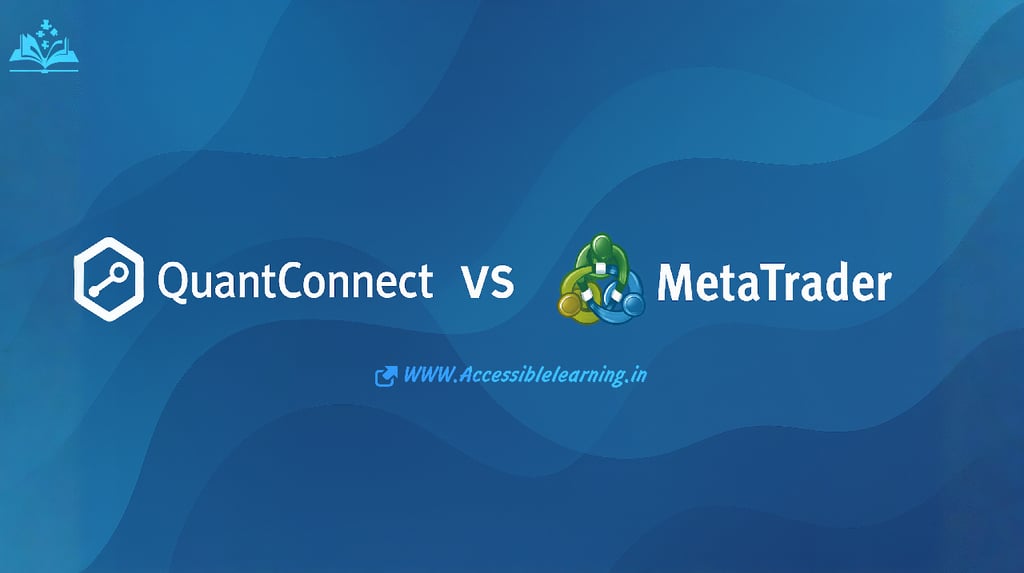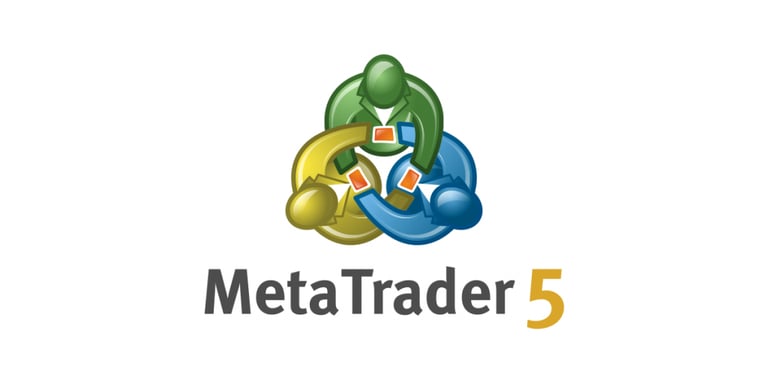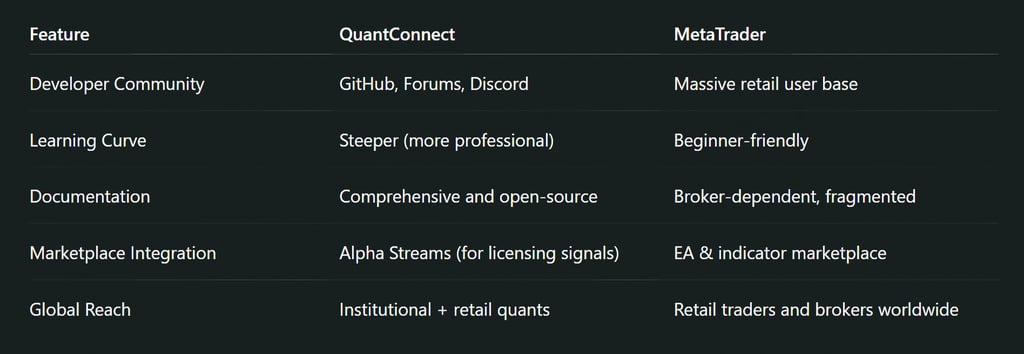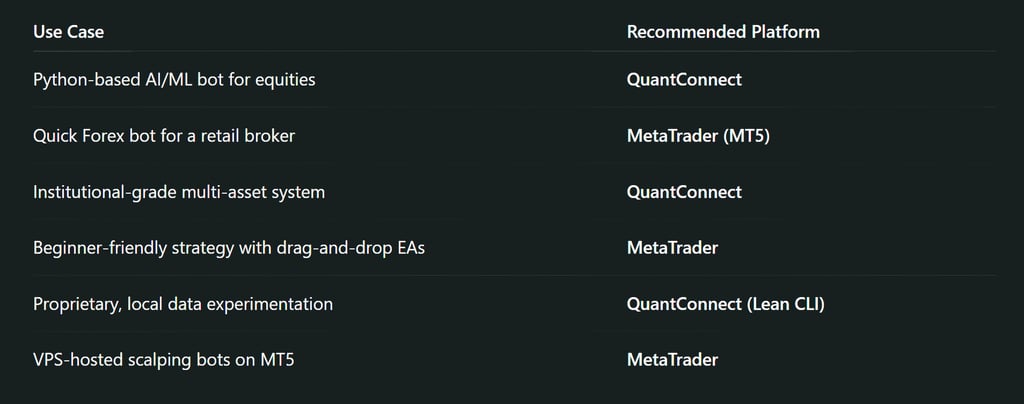
QuantConnect vs MetaTrader: Which Is Better for Coding a Trading Bot!
Explore the in-depth comparison between QuantConnect and MetaTrader for coding your own trading bot in 2025. Learn about advanced technical capabilities, coding environments, latency control, multi-asset support, and more to choose the best platform for your algorithmic trading goals.
AI ASSISTANTCOMPANY/INDUSTRYSTOCK MARKETBANKING/CASH-FLOWAI/FUTURE
Sachin K Chaurasiya
7/5/20255 min read


Algorithmic trading has become a dominant force in modern markets. From Wall Street to home offices, traders are increasingly automating their strategies to reduce emotional bias and increase efficiency. Two major platforms cater to this need—QuantConnect and MetaTrader—but they differ radically in design philosophy, coding paradigms, and user flexibility.
If you're considering building your own trading bot in 2025, this comparison will help you decide which platform aligns best with your goals, whether you’re a data scientist crafting multi-factor models or a retail trader automating a trend-following strategy.
QuantConnect
QuantConnect is built for institutional-level quant development. It runs on the open-source Lean engine, offering full algorithmic freedom for multi-asset strategies. QuantConnect is API-first and cloud-based, empowering developers to integrate large datasets, optimize models, and deploy strategies globally.
Core Philosophy: Quant-first, data-centric
User Base: Quantitative analysts, financial engineers, hedge funds
Programming Environment & Coding Workflow
Languages Supported: Python, C#
Code Environment: Cloud-based IDE and local CLI (Lean Engine)
Architecture: Event-driven model (OnData, OnEndOfDay, etc.)
Library Integration: Supports NumPy, Pandas, Scikit-learn, PyTorch, TensorFlow (Python only)
Custom Modules: Easily import external packages for signal processing, AI/ML, or statistical modeling
Data Access, Precision & Security
Asset Coverage: Equities, FX, Crypto, Futures, Options, ETFs
Data Granularity: Tick, Second, Minute, Daily
Historical Depth: 15+ years (some assets), with alternative data support (social sentiment, macro, fundamentals)
Custom Data: Upload your own CSV or external feeds for backtesting
Security: Encrypted storage and private deployments via Lean CLI
Compliance: GDPR, CCPA, institutional-grade data handling
Backtesting & Strategy Optimization
Backtest Engine: Lean Engine, parallelized, realistic fill/slippage modeling
Simulation Fidelity: Includes latency, bid/ask spread, partial fills
Machine Learning: Compatible with AI/ML models using Scikit-learn, LightGBM, or PyTorch
Multi-Strategy Testing: Supports portfolio-wide strategy execution and capital allocation
Broker Integration & Live Trading Deployment
Brokers Supported: Interactive Brokers, OANDA, Coinbase, Binance, Kraken, and more
API Execution: REST and WebSocket-based with cloud orchestration
Cloud Deployment: Available for free tier (paper trading) and paid tier (live trading)
Local Deployment: Possible using open-source Lean CLI
Latency: Configurable latency simulation for realistic tests
Licensing, Cost & Extensibility
Licensing: Lean Engine is open-source (Apache 2.0)
Usage Cost: Free for research and backtesting; live deployment requires tiered subscription (starting around $8/month)
Custom Extensions: Full Python or C# library integration
Lean CLI: Can run QuantConnect locally with your own data/broker


MetaTrader (MT4/MT5)
MetaTrader is a retail trading terminal, originally designed for Forex and later expanded to support CFDs, commodities, and crypto (via specific brokers). It uses its proprietary scripting language (MQL4/5) and emphasizes simplicity and accessibility.
Core Philosophy: Retail trading with plug-and-play automation
User Base: Independent traders, Forex brokers, beginner coders
Programming Environment & Coding Workflow
Asset Coverage: Primarily Forex and CFDs (broker-dependent)
Data Granularity: Tick (limited by broker feed), Minute, Hour, Daily
Historical Depth: Varies per broker; often lacks consistency
Custom Data: Not natively supported; workarounds required
Security: Depends on broker and VPS setup
Data Access, Precision & Security
Asset Coverage: Primarily Forex and CFDs (broker-dependent)
Data Granularity: Tick (limited by broker feed), Minute, Hour, Daily
Historical Depth: Varies per broker; often lacks consistency
Custom Data: Not natively supported; workarounds required
Security: Depends on broker and VPS setup
Backtesting & Strategy Optimization
Backtest Engine: MT4 (basic), MT5 (multi-threaded with optimization)
Simulation Fidelity: Spreads, slippage, swaps included; tick modeling depends on data source
Machine Learning: Not supported natively
Strategy Testing: Mostly for individual bots (Expert Advisors)
Broker Integration & Live Trading Deployment
Brokers Supported: Thousands of brokers offer MT4/MT5
Execution: Real-time via broker's built-in order system
Hosting: MT5 supports broker-hosted VPS for 24/7 trading
Latency: Not configurable in backtests
Bot Deployment: Drag-and-drop EA loading into terminal
Licensing, Cost & Extensibility
Licensing: Proprietary, free via brokers
Usage Cost: Zero for users; monetization via EAs, indicators
Custom Extensions: Limited to MQL capabilities
Marketplace: Large EA/indicator store for purchase or rental


QuantConnect (Advanced Technical Breakdown)
Latency Handling & Network Simulation
Supports latency modeling per broker/exchange using custom delay parameters (e.g., slippage modeling with latency variance).
Allows simulation of network jitter, execution lag, and packet loss to test high-frequency systems.
Uses fill models that account for venue-specific liquidity characteristics, ensuring realistic execution under live stress.
Multi-threading & Parallelism
Backtesting is parallelized across multiple cores or nodes via cloud distribution.
Supports task-based asynchronous programming, especially in C#, for real-time multi-threaded logic (e.g., parallel signal computation).
Can leverage multi-threaded custom libraries, including NumPy's parallel array operations.
Memory Management & Resource Scaling
Built-in memory watchdogs track leaks and enforce constraints in backtests and live environments.
You can optimize algorithms for RAM efficiency with caching strategies and garbage collection profiling.
Custom resource profiles (especially for institutional users) allow dynamic memory scaling during market spikes.
Real-time Data Streams & Event Architecture
Designed around event-driven logic (OnData, OnOrderEvent, OnSecuritiesChanged).
Custom scheduled events (e.g., rebalancing logic, monthly scans) with cron-like control.
Real-time data can be streamed via WebSocket or REST, allowing cross-system integration (e.g., trade dashboard, analytics console).
Execution Integrity & Failover Systems
Supports redundant failover systems on its cloud tier, rerouting algorithm execution if nodes fail.
Trade execution logs are stored across multiple availability zones (e.g., AWS S3 with version control).
Critical executions can be queued and confirmed via event receipt, ideal for regulated environments.
Compliance, Logging & Auditability
Auto-generates compliance logs, order trails, and event metadata in line with MiFID II and SEC guidelines.
Logs are downloadable and reviewable at every stage (backtest, live, debug).
Features a research notebook history that can be time-stamped for version audit.
Custom Signal Pipelines & Modular Architecture
Allows fully modular strategy design with classes for alpha models, risk models, execution models, and portfolio construction.
Developers can design plug-and-play components (e.g., swap one alpha model for another).
Ideal for multi-asset, hierarchical strategies using state machines or reinforcement learning agents.
Deployment & CI/CD Workflow
Supports full CI/CD pipelines using GitHub and Lean CLI.
Algorithms can be version-controlled, auto-tested, linted, and deployed from terminal or CI platforms (e.g., GitHub Actions).
Remote deployment to QuantConnect Cloud or on-prem infrastructure with Docker support.
MetaTrader (Advanced Technical Breakdown)
Latency Handling & Network Simulation
Latency is real-time only; there's no support for latency simulation in backtests.
Execution speed is entirely broker-controlled; no client-side latency modeling.
VPS solutions reduce latency, but network conditions can't be stress-tested or simulated locally.
Multi-threading & Parallelism
MT4 is single-threaded. Only one EA per chart; no true concurrency.
MT5 supports multi-threaded backtesting, but live execution remains serial per EA.
No support for managing worker threads within MQL—thread safety must be hard-coded using flags or queues.
Memory Management & Resource Scaling
Memory is handled by the MQL virtual machine with limited control.
Manual array clearing is often required to prevent bloat during prolonged runs.
No integrated memory profiling tools—developers must use third-party debuggers or trial-and-error methods.
Real-time Data Streams & Event Architecture
Operates on tick-driven events only (OnTick, OnTimer).
Lacks advanced event routing or scheduling frameworks.
You must simulate periodic checks (e.g., using Sleep() or a timer), which can be CPU-intensive and prone to missed ticks.
Execution Integrity & Failover Systems
No failover unless your VPS supports snapshots or replication.
Trade failures (e.g., order rejection) are handled by error codes but must be manually retried via code.
Log storage is local; loss of session or crash can result in log gaps or data loss.
Compliance, Logging & Auditability
Broker logs are stored on disk but not designed for compliance-grade auditing.
No native integration with compliance systems or timestamp-based version tracking.
Real-time alerts must be coded manually (e.g., Telegram bots or SMTP triggers).
Custom Signal Pipelines & Modular Architecture
EAs are often monolithic; modularity is limited and must be manually managed via included .mqh files.
Shared logic (e.g., risk models) must be copied across EAs unless abstracted into common libraries.
Architecture doesn’t support portfolio-wide optimization or multi-layer strategy design.
Deployment & CI/CD Workflow
No native CI/CD support.
Strategy updates require manual compilation and terminal-based deployment.
Broker restrictions often block automatic restarts or deployments.


If you're developing resilient, high-frequency, multi-strategy bots that need event accuracy, risk separation, and robust data processing, QuantConnect delivers an engineering-grade ecosystem.
MetaTrader, on the other hand, remains ideal for retail-focused automation with rapid deployment, but it lacks the deeper tooling required for data-rich, institution-scale strategy development.
Subscribe To Our Newsletter
All © Copyright reserved by Accessible-Learning Hub
| Terms & Conditions
Knowledge is power. Learn with Us. 📚


